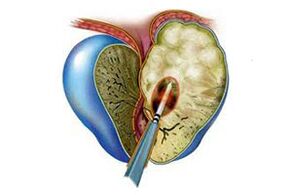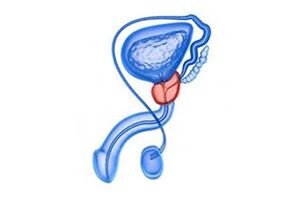Acute prostatitis is an acute inflammation of the prostate caused by infection.With this disease, the prostate forms swelling and pus foci appear in its tissues.Statistics give us the right to confirm that acute prostatitis in men is a common disease;With age, the risk of its appearance increases.
The effectiveness of treatment of acute prostatitis directly depends on the timeliness of the patient's treatment.The disease quickly develops into a chronic form, treatment is longer and more complicated.
Acute forms of prostatitis
If we talk about the clinical course of acute prostatitis in men, there are three forms (stages) of the disease:
- catarrhal;
- ovarian follicle;
- parenchyma.

The first to occur is catarrhal inflammation, which is characterized by dilation of the acini and the appearance of reactive edema of the interstitium.This leads to significant enlargement of the prostate.The next stage is the rapid spread of the inflammatory process to the lobules and excretory ducts of the prostate.In particular, we are talking about the excretory ducts of the prostate leading to the posterior part of the urethra.Inflammatory changes affect only the mucous membranes.The excretory ducts lose their ability to contract, narrow significantly, or become completely blocked, hindering the release of prostatic secretions.The catarrhal form is directly related to infectious pathogens that have migrated from the posterior part of the urethra.Because the inflammatory process also affects prostate secretion, it can cause posterior urethritis.
During the follicular phase, inflammatory foci reach and spread throughout the lobules or the entire prostate.Pus appears, pus enters the urethra.The enlargement of the prostate does not stop;Tissues undergo destructive changes.
During the parenchymal phase of acute prostatitis, inflammatory processes affect the interstitial tissue of the prostate.This stage occurs after an infectious pathogen enters through contact or blood, such as after surgery.
Parenchymal prostatitis at the beginning of the disease is accompanied by the appearance of single pustules, which in the process of development merge and combine with prostatic abscesses.
As for cystic and parenchymal forms, during their development, inflammatory changes often occur in the posterior part of the urethra and bladder neck.
Prediction and prevention of acute prostatitis
In the vast majority of cases, etiotropic therapy, carried out on time, can eliminate the signs of acute prostatitis.If left untreated, an abscess is likely to occur or the disease becomes chronic.
Preventing this disease usually means promptly treating any infectious diseases in the body, as well as identifying and treating sexually transmitted diseases and urethritis.Men need to have a healthy lifestyle, paying special attention to increasing physical activity.In addition, the development of the disease is prevented by regular sexual life and the absence of unprotected casual contact.Strict compliance with the rules of personal hygiene is another important requirement for men of all ages.
Cause of the disease
Acute prostatitis in men can occur at any age.The cause is often due to the invasion of many different infectious pathogens.This is E. coli but there can also be streptococcus, staph, Candida, chlamydia, trichomonas.The most common route of entry is the excretory ducts.Pathogens can also enter the prostate from the bladder, where the gland is undergoing an inflammatory process (eg, acute cystitis).Infection can also spread from pus pockets located in nearby areas.
The inflammatory process in the prostate caused by the presence of microorganisms can occur for many reasons.Factors that increase your risk include:
- Surgical intervention in the urethral area;
- unprotected sex, genital tract infections in partners;
- use of a urethral catheter;
- prostate stones, etc.
The occurrence of acute prostatitis may not be related to infection.It can occur due to a sedentary lifestyle, hypothermia and various disorders that lead to stagnation in the pelvic area.
Symptoms of acute prostatitis
Because acute prostatitis has many different stages, the symptoms of the disease often depend on each stage.But there are common features that unite all forms.First of all, it is a feeling of pain, general intoxication, as well as problems with the urination process.
The catarrhal form is often accompanied by severe pain, a feeling of heaviness in the perineum, frequent urination, accompanied by a painful sensation.During palpation, the doctor may notice an increase in the size of the prostate.Secretion test results may show high white blood cell levels.

Symptoms of acute cystic prostatitis are more pronounced.A man feels pain in the perineum, radiating down to the sacrum or penis.The urination process is accompanied by pain, urine stagnation, and difficulty defecating frequently.General malaise and the patient has a fever.Palpation shows that the prostate is enlarged, its outline becomes asymmetrical.Localized pain may occur.Tests showed an increase in the level of leukocytes and the presence of pus threads in the urine.
The parenchymal form is accompanied by a sharp increase in body temperature, the value of which can reach 39.5 degrees.General symptoms are clearly manifested: chills, loss of appetite and lack of strength.Urination is delayed, this process is accompanied by severe pain.Defecation is also difficult and constipation becomes severe.
In such cases, it is necessary to urgently begin treatment of acute prostatitis.If the process is started, there is a high probability of prostatic abscess, prostatitis, paraprostatic venous plexus phlebitis.If the patient does not go to the doctor, the disease will become chronic and the possibility of complete recovery will be significantly reduced.
Diagnosis of acute prostatitis
When the patient contacts a urologist, the doctor will diagnose acute prostatitis and determine what stage the disease is at.The specialist receives information after conducting a comprehensive study.The methods used in diagnosis in this case include physical, instrumental and laboratory studies.
Physical examination includes studying the condition of the prostate from the rectum.Therefore, the specialist has the opportunity to evaluate the size, shape, consistency of the organ and the presence of pain.As a result of analysis of secreted secretions, a decrease in the number of lecithin granules and an increase in the level of leukocytes can be easily determined.
Glandular palpation also involves collecting and transferring urine for examination.In most cases, acute prostatitis is signaled by an increase in the level of white blood cells.Urine culture, PCR and blood culture, analysis of urethral secretions are also prescribed.
Instrumental methods in the case of this disease are represented by ultrasound diagnostics performed through the rectum.If the patient has severe pain, the examination of choice is the transabdominal method.
When the question of surgical intervention arises, conducting pelvic CT and MRI scans is necessary.
Treatment of acute prostatitis
Treatment of acute prostatitis is performed in a hospital.This is due to two factors.First, there is a risk of serious complications that can affect men's health and subsequently affect reproductive function and erection quality.Second, the disease progresses complicatedly, accompanied by clear symptoms and painful feelings.Treatment of acute prostatitis begins with drug therapy, prescribing etiotropic drugs to the patient.The most important role is played by antibacterial substances that inhibit the activity of microorganisms.
To reduce the severity of pain, as well as get rid of spasms, the patient should take antispasmodic and pain relievers.Sometimes thermal enemas and rectal suppositories are used to relieve this condition.Once acute symptoms are resolved, physical therapy can be used.These procedures increase microcirculation, improve local immunity and help eliminate inflammation.Among the physiotherapeutic methods of treating acute prostatitis, the most effective are prostate massage, as well as microwave therapy and electrophoresis.For many years, prostate massage has been considered a particularly popular method, helping to eliminate congestion;it is also recommended for regular use as a preventative measure for men who have reached the age of forty.
In case of problems with the urinary process, do not use a catheter;instead, trocar cystectomy is preferred.
Recovery is considered the regeneration of prostate tissue, complete restoration of its functions, while laboratory tests show the absence of infectious pathogens and prostatic secretions return to normal composition.
Surgery is not a widely used treatment for prostatitis.It doesn't always bring results.Surgical solutions provide positive momentum in less than half of cases.The most common side effects of surgery are erectile dysfunction, retrograde ejaculation is also common. During ejaculation, sperm enters the bladder, sometimes ureteral stenosis occurs.Surgical methods do not guarantee against recurrence.Therefore, surgical intervention is only used in certain cases, such as:
- the appearance of a prostatic abscess, which must be opened and cleaned;
- Conservative treatment with medications, traditional medicine, and physical therapy does not bring results;
- development of serious complications;
- the presence of inflammation in the pelvic area;
- formation of paraproctitis (purulent abscess in the cells localized around the rectum);
- presence of blood in urine;
- slow and stopped urination (anuria);
- the presence of stones in the bladder, kidneys, the cause is prostatitis;
- suspected malignant tumor.































